IN THIS ISSUE
- Bird-feeding strategy for winter
- Invasion of the Cuban treefrogs
- New Georgia darter discovered
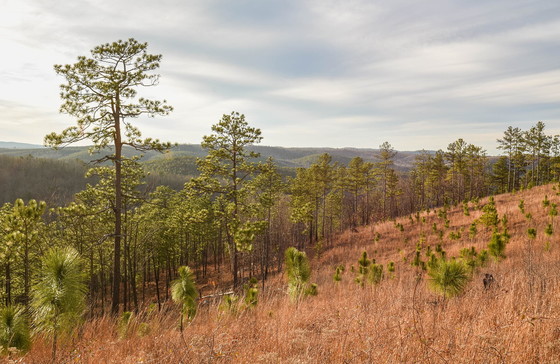 Restoring montane longleaf pine at Sprewell Bluff WMA (Hal Massie/DNR)
Are you thankful for Georgia’s wildlife? Would you like to help make sure these animals, plants and the wild places they need are conserved for future generations?
Here are five things you can do.
-
Buy or renew an eagle, hummingbird or monarch license plate. Each is only $25 more than a standard tag and up to 80 percent goes directly to Georgia’s Nongame Wildlife Conservation Fund.
-
Donate to the Wildlife Conservation Fund online. (If you don’t have a customer account, just click “Licenses and Permits” to create one.)
-
Contribute through the Wildlife Conservation Fund state income-tax checkoff.
-
Purchase a hunting or fishing license. Each sale returns to Georgia wildlife the license fee and up to $45 in federal excise taxes paid by hunters and anglers. A license also gives you access to the majority of state-run wildlife management areas, as well as Voluntary Public Access lands.
-
Volunteer with DNR and join conservation organizations such as TERN, the DNR Wildlife Conservation Section’s friends group.
Learn more at georgiawildlife.com/donations. Explore how your support is put to work at georgiawildlife.com/conservation/annualreport.
EXTRA INCENTIVES FOR 2020 CONTRIBUTIONS
Remember, federal tax changes included in the pandemic-focused CARES Act offer new incentives for donations to nonprofits, but only in 2020. Benefits are available for individual and corporate donors. Consult a tax professional for details.
Top
 Carolina wrens eating suet (Terry W. Johnson)
By TERRY W. JOHNSON
Feeding birds in winter is a favorite pastime for thousands of Georgians. However, as with so many endeavors, some folks enjoy more success than others. Which begs the question: What’s their secret?
After feeding birds for more decades than I care to mention, I have learned it is easier than you think. Just keep in mind the best way to attract all sorts of birds in winter is to provide them with food and water.
The trick is finding the right combination that works in your backyard. Here's what I’ve found works in mine …
Read the rest of Terry’s column for tips on seed mixes and other insights.
Terry W. Johnson is a retired DNR program manager and executive director of TERN, the Wildlife Conservation Section’s friends group. Check out past columns, his Backyard Wildlife Connection blog and his book “A Journey of Discovery: Monroe County Outdoors.” His columns are also featured on DNR’s blog, under the Conservation tab. Permission is required to reprint any of Terry’s columns.
Top
 Kingsland resident Laura Stevenson photographed this Cuban treefrog in her driveway. (Special to DNR)
Laura Stevenson was taking out the trash Halloween night when she spotted it: a large, odd-looking frog in the driveway of the family’s Kingsland home.
“I thought, ‘Holy cow, that’s the biggest frog I’ve ever seen!’” Stevenson said.
Intrigued, the Indiana native did what she usually does when she sees something interesting and unfamiliar: She took photos and Googled it.
What Stevenson learned, and biologists later confirmed, was spooky. The frog was a Cuban treefrog.
These Caribbean amphibians turned up in Key West in the 1920s and have gradually spread north, hitchhiking on vehicles, boats and plants. Now established across much of Florida and, as of 2017, in New Orleans, their advance has come at the expense of native wildlife, particularly treefrogs.
Cuban treefrogs grow big – females can top 5 inches long – readily eat other frogs and can out-reproduce natives such as green treefrogs. In Florida, the invaders are blamed for declines of some native treefrogs.
DNR documented Georgia’s first Cuban treefrog in 2004. More reports followed, many along the coast, with Savannah and Brunswick emerging as hotspots. Yet no breeding population has been confirmed.
Daniel Sollenberger, a DNR senior wildlife biologist, knows it’s likely a matter of time before this mega-treefrog with oversized toepads gains a foothold here. But he also knows that dealing with invasive species is more effective before they become established. And he is urging people to report sightings.
Here’s how, plus some identification keys:
- If possible, catch the suspected Cuban treefrog alive, put it in a clear container and email a photograph to daniel.sollenberger@dnr.ga.gov for identification.
- Confirming the ID is important: Native species such as squirrel, barking and Cope’s gray treefrogs could be mistaken for Cuban treefrogs.
- Tip-offs beyond the animal’s size: Cuban treefrogs have exceptionally large toe pads, “bug eyes” and usually numerous small warts. The coloration of the frogs varies widely.
- The breeding call of males has been described as a high-pitched snoring rasp and compared to the sound of grating a stone. Listen.
- One caution: Cuban treefrogs emit a skin secretion that can irritate a person’s eyes and nose. Wash hands thoroughly after handling.
- Like most of their amphibian kin, Cuban treefrogs will eat anything they can stuff in their mouths, from green treefrogs to Christmas lights.
Top
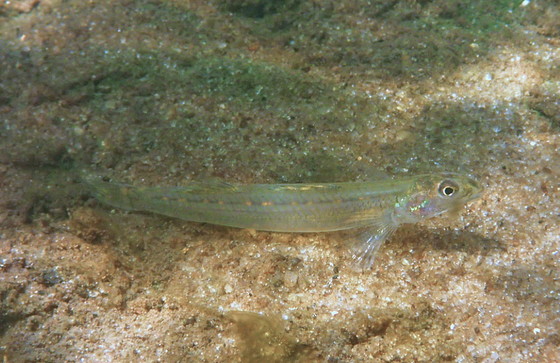 Florida sand darter (Christine Fallon/UGA)
Florida sand darters weren’t supposed to be in Georgia.
The slender, 3-inch-long fish with almost see-through bodies and a tendency to bury themselves up to their eyes in sand on stream bottoms are known from Gulf Coast drainages in northwest Florida and south Alabama. But Florida sand darters had never been found in Georgia.
Until June 2013. During a Georgia River Network trip on the Flint River near Newton, retired ichthyologist Dr. Camm Swift told DNR’s Dr. Brett Albanese he had just caught and released sand darters at a nearby sandbar. With help from DNR and other trip-goers, the scientists collected and photographed more of the darters.
Coloration and scale counts suggested they were Florida sand darters, a species described in 1975. Work by Mansfield University geneticist Greg Moyer and a grant from The Environmental Resources Network, friends group of DNR’s Wildlife Conservation Section, confirmed the identification, revealing a close relationship between the Flint fish and sand darters in Alabama and the Florida Panhandle.
How sand darters made it to the Flint River – did anglers introduce them as bait? – or whether they have been in the system and simply eluded detection is a mystery.
Albanese and Swift recorded the darters at only three of 15 sites surveyed on the Flint between Albany and Bainbridge. However, UGA graduate student Christine Fallon discovered more last year while snorkeling Ichawaynochaway Creek as part of her work at The Jones Center at Ichauway.
The sand darter’s behavior – part of their scientific name Ammocrypta comes from Greek root words for “sand” and “concealed” – and the deep, rocky habitats of the Flint and its tributaries could help explain why the species was not documented before. As Albanese said, it’s hard to find a fish buried in sand in a deep, rocky river. The difficulty of catching these fish for bait and additional records in Florida’s Apalachicola drainage – the Flint helps form the Apalachicola – also support the hypothesis that Florida sand darters are native to Georgia.
“Most people would think that our fish fauna is completely known, but there are still exciting discoveries to make,” said Albanese, a program manager with the Wildlife Conservation Section.
FOR MORE
The findings on Florida sand darters in Georgia will be published in an upcoming Southeastern Fishes Council Proceedings. Explore Georgia’s fish diversity at georgiawildlife.com/freshwaterfish.
Top
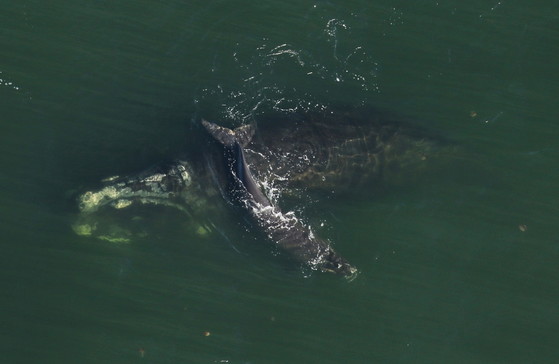 Right whale mother with her injured calf in January (FWC/NOAA permit 18786-04)
When North Atlantic right whales return this winter to their only known calving grounds off the Georgia and north Florida coast, there will be fewer of them. NOAA estimates the number of the endangered whales dropped from 412 in January 2018 to 366 in January 2019. The new estimate concerns Clay George, DNR’s lead marine mammal biologist. But George said he is more troubled by the species’ overall population trend, which has spiraled down after peaking this century at 481 whales in 2011. Those gains have since been lost to whales dying from ship strikes and entanglement in commercial fishing ropes, and a calving downturn caused at least in part by plankton changes in New England and Canada. NOAA has documented 31 deaths and another 11 whales injured since 2017, including the newborn apparently hit by a vessel last winter and now presumed dead. (Update: As of this week, a right whale seen 22 miles off Charleston, S.C., in late October is the only one reported in the Southeast so far this season.)
Despite the nation’s political divide, 2020 proved a watershed year for conservation legislation. The latest example: On Oct. 30, President Trump signed into law America’s Conservation Enhancement Act, a bipartisan bill that reauthorizes the North American Wetlands Conservation Act, the National Fish and Wildlife Foundation and the Chesapeake Bay Program, while also increasing funding for the Wetlands Conservation Act, which has helped conserve more than 30 million acres of wetlands.
Top
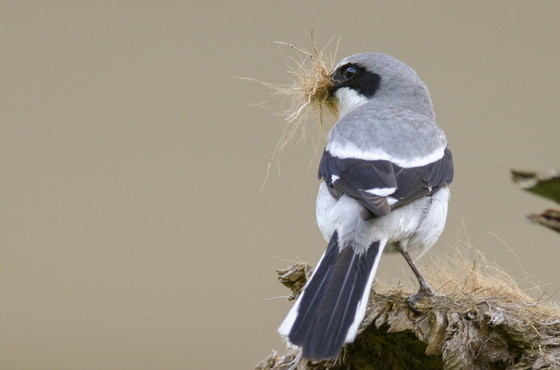 Loggerhead shrike with nesting material (Ty Ivey/Georgia Nature Photographers Association)
Grassland birds and small game will benefit from recent logging at Joe Kurz Wildlife Management Area near Gay. The harvest removed rows of trees fragmenting grasslands and thinned acres of pine plantation, making way for the long-term job of replacing understory sweetgums and non-native trees and shrubs with natives such as elderberry and Chickasaw plum for wildlife food and cover.
Know of a wildlife-viewing project that could use a helping hand? DNR is accepting proposals for 2021 Wildlife Viewing Grants, up to $3,000 for efforts that connect people with animals, plants and natural habitats emphasized in Georgia’s State Wildlife Action Plan.
The first round of monitoring is finished for plots set up this summer to track endangered hairy rattleweed on Sansavilla Wildlife Management Area’s Wire Road Tract. One focus is how prescribed fire and other habitat management affects populations of the plant known from only Wayne and Brantley counties.
Top
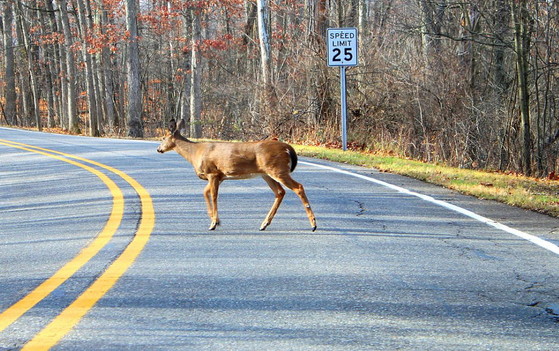 The risk of deer/car collisions rises as the rut peaks.
Georgia drivers are urged to stay alert and scan the roadsides as mating season for deer has white-tails on the move, and the time change has more commuters on the road at dusk and dawn. Remember that deer are unpredictable, most active at dawn and dusk, and seeing one usually means more are nearby.
The 2021 Georgia Fish Art Contest offers youth in grades K-12 the chance to win prizes and earn recognition while learning about fish, fishing and conservation. Entries for the competition, part of the international Wildlife Forever State-Fish Art Contest, are due by March 31.
Fifth-graders and their families have a free pass until Aug. 31 at national parks, wildlife refuges and other Interior Department lands. Interior Secretary David Bernhardt said the move ensures that children who were unable to take advantage of fee waivers as fourth-graders last year because of the pandemic will have free access to explore the outdoors on federal lands this school year.
Top
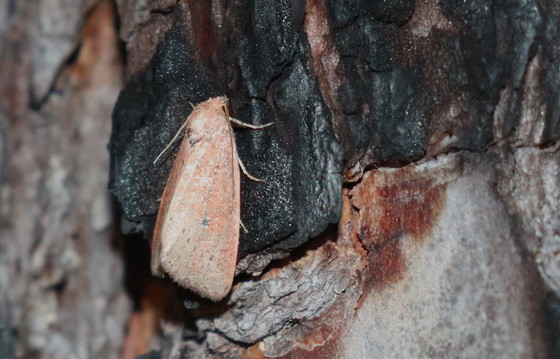 Photedes carterae on a pine tree at the south Georgia bog (Anna Yellin/DNR)
A southeast Georgia bog surveyed monthly to record the moths it supports yielded a November surprise. DNR wildlife biologist Anna Yellin and Dr. Lance Durden of Georgia Southern University documented more than 82 species in four hours, and one was Carter’s noctuid moth (Photedes carterae), a rare species known only from North Carolina, possibly New Jersey and Georgia, including Doerun Pitcherplant Bog Wildlife Management Area in Colquitt County and now this site. The latter is being restored by the landowner, DNR's Wildlife Conservation Section and the Georgia Plant Conservation Alliance (“Rare moths and more,” August).
The 2020 version of Dr. Alan Weakley's Flora of the Southeastern United States is available online at the University of North Carolina at Chapel Hill Herbarium. The go-to guide for botanists covers more than 10,000 species from eastern Texas to Delaware and parts of the Midwest.
Names in the news: DNR Wildlife Resources Division Director Rusty Garrison is retiring this month, and DNR Commissioner Mark Williams has announced the appointment of Ted Will as director, effective Dec. 1. Will, a 20-year division veteran, is serving as assistant director but has also worked as chief of the agency’s Game Management Section, assistant chief in both Game and Fisheries Management, fisheries region supervisor and fisheries biologist. Williams said he is "beyond confident" that the division’s "outstanding legacy known across the country of protecting and conserving Georgia’s wildlife" will be continued under Will.
WHAT YOU MISSED ...
In the previous Georgia Wild:
- Exploring Chickasawhatchee WMA
- Asian spider weaves way into Georgia
- Native tree combines beauty and bounty
- Rare plant rebounds at Lower Broad River
Top
"Frecklebelly madtom could get Endangered Species Act protection," Georgia Recorder
(+video) "Invasive fish discovered in Athens-area creek," UGA
"Right whale calving season underway," WJXT-TV (Ch. 4, Jacksonville, Fla.).
Other North Atlantic right whale news: "Rescuers tracking entangled whale" (Wickedlocal.com); "Ropeless gear gains urgency in bid to save right whales (Cape Cod Times, Maine); "Boats keep striking, killing whales" (Salon); "Researchers study how ocean noise affects right whales" (Canadian Broadcasting Corp.)
"Cabin Bluff tract designated WMA," The Brunswick News
"DNR accepting proposals for Wildlife Viewing Grants," The Albany Herald. Also: The Chatsworth Times.
"It's a scary time for bats," The Atlanta Journal-Constitution
"Giant tegu lizards moving into Georgia," Discover
"Invasive lizards in Fla. adapt to colder temperatures," The Wildlife Society. Study published in Biology Letters.
"S.C. passes bill to fight non-native reptile species," WRDW-TV (Ch. 12, Augusta)
"Reptile keepers balk at new Fla. rules for invasives," Orlando (Fla.) Sentinel
"USDA uses radio tags to infiltrate nests of Asian giant hornets," USDA. Also: "Scientist who vacuumed murder hornets braces for fight," The Guardian
"What it takes to dismantle and move a right whale skeleton," Atlas Obscura
Top
 "Talking Nature Tuesday: Invasive Exotics," DNR
"Cultivating the Wild: William Bartram's Travels" (with this bonus segment including DNR's Shan Cammack talking about prescribed fire), South Carolina ETV
"'It Was Like a Blubber Snowstorm:' Why Oregon Blew up a Whale in 1970," Oregon Public Broadcasting
CREDITS
Masthead: Cuban treefrog (Brad Glorioso/USGS)
Top
|